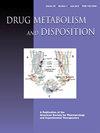After fifty years of hepatic clearance models, where should we go from here? Improvements and implications for PBPK modeling
IF 4.4
3区 医学
Q1 PHARMACOLOGY & PHARMACY
引用次数: 0
Abstract
There is overwhelming preference for application of the unphysiologic, well-stirred model (WSM) over the parallel tube (PTM) and dispersion (DM) models to predict hepatic drug clearance, CLH, despite that liver blood flow is dispersive and closer to the DM in nature. The reasoning is the ease in computation relating the hepatic intrinsic clearance (CLint), hepatic blood flow (QH), unbound fraction in blood (fub) and the transmembrane clearances (CLin and CLef) to CLH for the WSM. However, the WSM, being the least efficient liver model, predicts a lower EH that is associated with the in vitro CLint (Vmax/Km), therefore requiring scale-up to predict CLH in vivo. By contrast, the miniPTM, a 3-subcompartment tanks-in-series model of uniform enzymes, closely mimics the DM and yielded similar patterns for CLint vs. EH, substrate concentration [S], and KL/B, the tissue to outflow blood concentration ratio. We placed these liver models nested within PBPK models to describe the kinetics of the flow-limited, phenolic substrate, harmol, using the WSM (single compartment) and the miniPTM and ZLM (zonal liver) models of evenly- and unevenly-distributed glucuronidation and sulfation activities, respectively, to predicted CLH. For the same, given CLint (Vmax and Km), the WSM again furnished the lowest extraction ratio (EH,WSM = 0.5) compared to the miniPTM and ZLM (>0.68). Values of EH,WSM were elevated to those for EH,PTM and EH,ZLM when the Vmaxs for sulfation and glucuronidation were raised 5.7 to 1.15-fold. The miniPTM is easily manageable mathematically and should be the new normal for liver/physiological modeling.肝清除模型问世五十年后,我们该何去何从?PBPK 模型的改进和影响
在预测肝药清除率(CLH)时,尽管肝血流具有分散性,在本质上更接近于 DM,但绝大多数人还是倾向于应用非生理学的、搅动良好的模型(WSM),而不是平行管(PTM)和分散(DM)模型。理由是 WSM 易于计算肝脏固有清除率(CLint)、肝血流量(QH)、血液中未结合部分(fub)和跨膜清除率(CLin 和 CLef)与 CLH 的关系。然而,作为效率最低的肝脏模型,WSM 预测的 EH 较低,与体外 CLint(Vmax/Km)相关,因此需要放大才能预测体内的 CLH。与此相反,miniPTM(一种均匀酶的 3 个亚室串联罐模型)与 DM 非常相似,并得出了相似的 CLint vs. EH、底物浓度 [S] 和 KL/B(组织与流出血液浓度比)模式。我们将这些肝脏模型嵌套在 PBPK 模型中,使用 WSM(单室)以及 miniPTM 和 ZLM(分区肝脏)模型分别使用均匀分布的葡萄糖醛酸化和不均匀分布的硫酸化活性来预测 CLH,从而描述流动受限的酚类底物--harmol 的动力学。对于相同的给定 CLint(Vmax 和 Km),与 miniPTM 和 ZLM(0.68)相比,WSM 再次提供了最低的提取率(EH,WSM = 0.5)。当硫酸化和葡萄糖醛酸化的最大 Vmax 提高 5.7 到 1.15 倍时,EH,WSM 的值就会提高到 EH,PTM 和 EH,ZLM 的值。miniPTM 易于数学处理,应该成为肝脏/生理建模的新标准。
本文章由计算机程序翻译,如有差异,请以英文原文为准。
求助全文
约1分钟内获得全文
求助全文
来源期刊
CiteScore
6.50
自引率
12.80%
发文量
128
审稿时长
3 months
期刊介绍:
An important reference for all pharmacology and toxicology departments, DMD is also a valuable resource for medicinal chemists involved in drug design and biochemists with an interest in drug metabolism, expression of drug metabolizing enzymes, and regulation of drug metabolizing enzyme gene expression. Articles provide experimental results from in vitro and in vivo systems that bring you significant and original information on metabolism and disposition of endogenous and exogenous compounds, including pharmacologic agents and environmental chemicals.

 求助内容:
求助内容: 应助结果提醒方式:
应助结果提醒方式:


